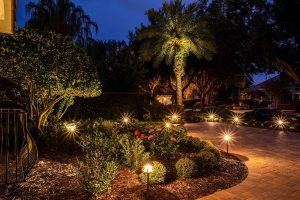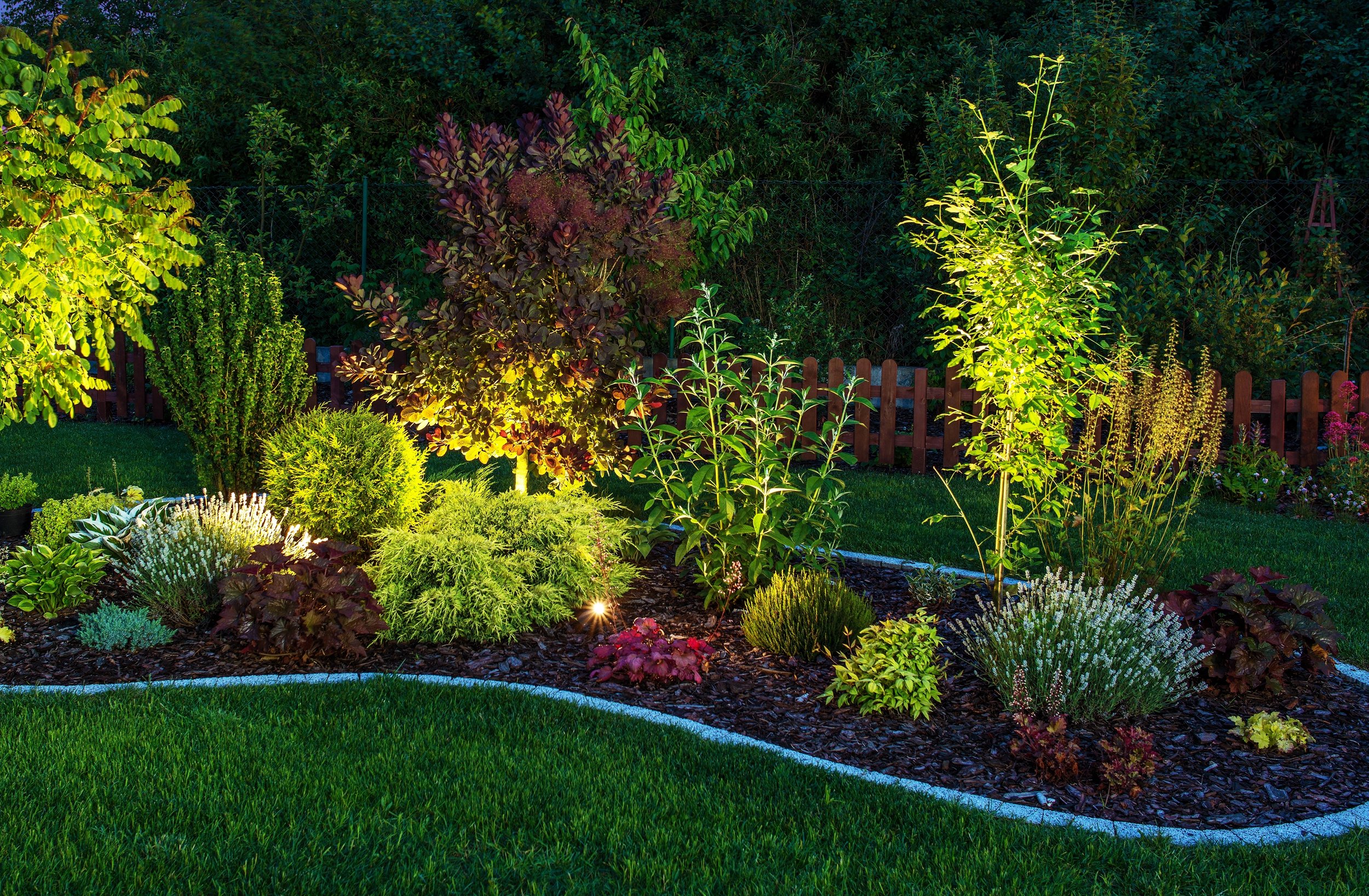Outdoor garden lighting is more than just a functional necessity—it’s an art form that can transform your outdoor space into a warm, inviting, and even magical retreat. Whether you’re aiming for safety, ambiance, or dramatic landscape effects, the right lighting can highlight your garden’s best features while allowing you to enjoy it long after the sun goes down. This guide covers all the major types of outdoor lighting, including design tips and practical considerations.
1. Path Lighting
Purpose: Safety, navigation, and subtle ambiance.
Description: Path lights are small fixtures that line walkways, garden paths, or driveways. They’re typically low to the ground and spaced evenly to illuminate the way without being overpowering.
Best Use: Use them along garden paths, steps, and driveways to create a guided experience while ensuring safety at night.
Popular Options:
-
Solar-powered stake lights (eco-friendly and easy to install)
-
Low-voltage LED path lights (durable and energy-efficient)
-
Modern or decorative designs to match garden themes
Design Tip: Avoid “runway effect” by staggering lights or mixing with low shrub uplights for a natural look.
2. Spotlights
Purpose: Highlight focal points like trees, sculptures, or architectural elements.
Description: Spotlights cast a focused beam of light and are great for drawing attention to specific features in your garden.
Best Use: Use spotlights to accentuate trees, water features, large plants, or garden structures like pergolas.
Popular Options:
-
Adjustable LED spotlights
-
Color-changing options for dynamic effects
-
Directional ground-mounted or wall-mounted fixtures
Design Tip: Angle spotlights slightly upward and position them away from sightlines to avoid glare.
3. Floodlights
Purpose: Broad area illumination for security and large-scale visibility.
Description: Floodlights emit a wide beam of intense light, covering a large area. Often used near garages or the backyard perimeter.
Best Use: Install at entry points, garage doors, or large open spaces in the garden that need more light for security or nighttime use.
Popular Options:
-
Motion-sensor floodlights (enhanced security)
-
Dusk-to-dawn LEDs
-
Smart floodlights controlled via app
Design Tip: Choose warmer color temperatures for a softer glow that’s still functional but less harsh.
4. Uplighting
Purpose: Create dramatic visual effects and highlight vertical features.
Description: Uplighting involves placing lights at ground level, aiming the beam upward. This creates strong shadows and emphasizes texture.
Best Use: Ideal for trees, columns, textured walls, or tall plants.
Popular Options:
-
In-ground well lights
-
Bullet spotlights with adjustable heads
-
Recessed uplights for a sleek look
Design Tip: Combine uplighting with downlighting to layer the light and add depth.
5. Downlighting (Moonlighting)
Purpose: Mimic natural moonlight and provide subtle, ambient lighting.
Description: Lights are installed high up, such as in trees or on eaves, and directed downward to cast soft shadows below.
Best Use: Use over patios, garden beds, or outdoor seating areas for gentle illumination.
Popular Options:
-
Tree-mounted fixtures
-
Wall-mounted sconces with downward direction
-
Hidden light sources for a natural look
Design Tip: Use filters or diffusers to soften the light and avoid harsh shadows.
6. String Lights & Fairy Lights
Purpose: Add charm, festivity, and ambiance.
Description: String lights are versatile and decorative, available in many shapes and sizes from classic bulbs to delicate fairy lights.
Best Use: Hang over patios, pergolas, fences, or weave through trees and shrubs.
Popular Options:
-
Solar or USB-powered fairy lights
-
Edison bulb string lights for vintage flair
-
Color-changing or smart string lights
Design Tip: Layer string lights with other types of lighting for a balanced mix of form and function.
Also Check: Outdoor Garden Lighting
7. Lanterns & Portable Lighting
Purpose: Flexible lighting and decorative flair.
Description: Lanterns can be hung, placed on the ground, or carried. They come in various styles including Moroccan, rustic, modern, or solar-powered designs.
Best Use: Great for picnic tables, garden parties, or accenting quiet corners.
Popular Options:
-
Candle lanterns (real or LED)
-
Solar-powered garden lanterns
-
Rechargeable LED lanterns with adjustable brightness
Design Tip: Group lanterns in threes of varying heights for a curated look.
8. Wall Lights & Sconces
Purpose: Functional and architectural lighting for vertical surfaces.
Description: Mounted on walls, these lights can provide general illumination and add to the overall design aesthetic.
Best Use: Perfect for outdoor walls, patios, entryways, and garden walls.
Popular Options:
-
Motion-sensor wall lights
-
Decorative sconces
-
Flush-mount or gooseneck barn-style fixtures
Design Tip: Choose fixtures that complement your home’s architectural style for a cohesive look.
9. Deck and Step Lighting
Purpose: Safety and subtle ambiance for outdoor structures.
Description: These low-profile lights are built into decks, stairs, or railings to gently illuminate walking areas.
Best Use: Use on stair risers, deck edges, or railings to prevent trips and falls.
Popular Options:
-
LED strip lighting
-
Recessed step lights
-
Solar-powered deck lights
Design Tip: Ensure fixtures are weatherproof and well-protected from foot traffic or moisture.
10. Underwater & Pond Lighting
Purpose: Illuminate water features for a magical nighttime effect.
Description: Waterproof lights can be placed in ponds, fountains, or around waterfalls.
Best Use: Highlight koi ponds, bubbling fountains, or streams.
Popular Options:
-
Submersible LED lights
-
Floating solar lights
-
Fiber optic lighting for custom effects
Design Tip: Avoid harsh lighting underwater—go for soft, warm LEDs to enhance the reflective quality of water.
Lighting Design Tips for Gardens
-
Layer the Light: Mix different lighting types (ambient, task, and accent) for a balanced and immersive environment.
-
Use Warm Color Temperatures: Aim for 2700K–3000K LEDs to create a cozy atmosphere.
-
Think About Shadows: Play with shadows from trees, plants, and structures to create depth.
-
Hide the Source: Conceal fixtures where possible for a cleaner look and to reduce glare.
-
Plan for Power: Use low-voltage systems or solar lighting where wiring is limited.
-
Consider Timers and Smart Controls: Automate your lighting with dusk-to-dawn sensors, motion detectors, or smart home integration.
Conclusion
The right combination of outdoor garden lighting can completely transform your outdoor living experience. Whether you’re entertaining, relaxing, or simply admiring your garden from inside, well-thought-out lighting enhances both the beauty and functionality of the space. With so many options available—from elegant lanterns and dramatic uplights to smart-controlled spotlights and eco-friendly solar path lights—there’s a solution for every taste, budget, and garden style.
